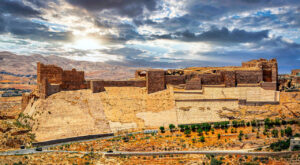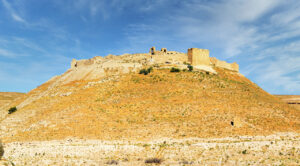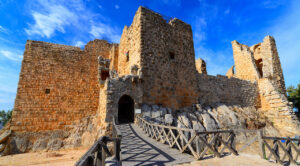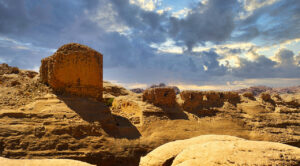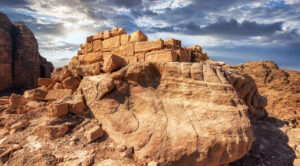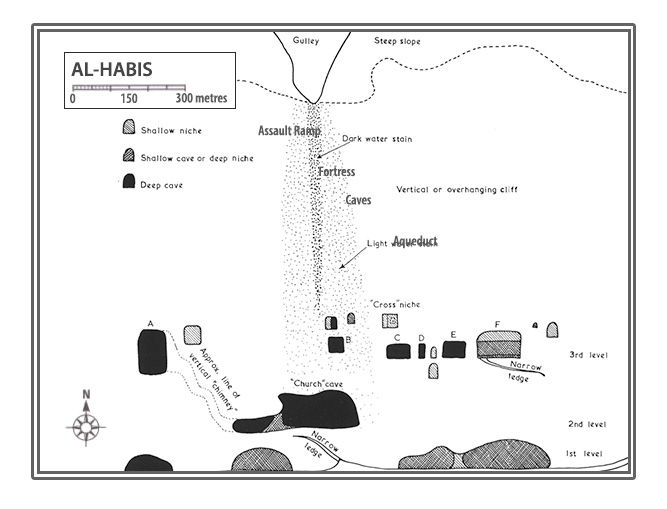Ledge- and cave-fortresses are not usually included in the typologies of Crusader castles because they rely almost entirely upon their natural locations for defence, with man-made structures playing a secondary role. A good example of such fortifications is Castle Al-Habis (Cave de Sueth) built by the Crusaders in 1115 AD. Measuring 156,5 m by 74 m, the fortress was difficult to access, providing reinforced protection from attacks which played a significant role in the military control of Petra during this period.

Many of the surviving defences probably date from after Nur al-Din unsuccessfully besieged the cave-fortress in 1158. Wooden stairs, ladders and walkways almost certainly linked the three levels of caves, presumably being partially removable in an emergency. The Crusader chronicler William of Tyre described the Cave de Sueth as being set on a vertical cliff, inaccessible from above or below and reached solely by a precipitous path across the mountainside. The caves, he said, consisted of rooms fully supplied with the necessities of life plus plenty of good water. It is even possible that the garrison was supplied with livestock stabled in the lower caves.
The eastern face of the rock contains several unusual monuments; the ‘Columbarium,’ its inner chamber and most of its walls covered by small square niches and the Unfinished Tomb, only the upper part of which was completed. At the peak of the al-Habis processional way is a small high place that served a religious function.
The urban fortifications of the Crusader States were similar to those of neighbouring Islamic cities and, in fact, largely consisted of walls, towers and gates constructed before the Crusaders arrived. When these were repaired by the Christian conquerors, limited modifications were introduced, such as varied styles of stonework and the shape or position of new towers.
The Cave de Sueth was often raided, attacked or besieged, and fell to one side or the other several times. Unfortunately, the site is also very vulnerable to earthquakes and has suffered severe damage during its recorded history, both before and since the Crusader period. As a result, most of the cliff face has collapsed into the deep valley of the River Yarmouk. Nevertheless, several man-made caves survive: some are still complete, others have only partial remains, and a few are only visible now as recesses in the cliff.
Three basic stones were available: hard limestone, softer limestone, and very hard volcanic basalt. Each had its characteristics and limitations. Normally Middle Eastern builders used what was locally available, stone only being transported long distances for a specific structural reason or aesthetic considerations.
The methods used to attach any outer wooden structures can only be guessed at, though the existence of such external galleries or hoardings is strongly suggested in various accounts of the Cave. In this reconstruction, a timber hoarding has been placed outside what appears to have been the most important caves in the complex, at what has been termed the ‘third level. Their openings led into what seems to have been a water-storage cistern and a series of neatly carved chambers that originally formed part of an Eastern Christian laura or monastic retreat. The timber hoarding or gallery itself has been envisaged as a smaller, more cramped and necessarily more flimsy version of the only complete and original timber hoarding to survive in Western Europe, which is located at Laval castle in France and dates from the 13th century.
Although only the ruins remain today, in their original state the fort was an impressive construction located in a strategic position along the trade route from Egypt. It is easily accessible and could be visited on your way to the Monastery.

The history of this cave-fortress begins with the Crusaders’ fortification of the lower Yarmouk valley in 1105. The invaders knew the area as the Terre de Suethe, from the Arabic word sawad meaning ‘cultivated zone’, in contrast to the semi-desert further east. That same year the area was ravaged by the ruler of Damascus, who also destroyed a new Crusader outpost on the Golan Heights. Instead of provoking further retaliation by building a castle on the Heights, the Crusader Prince of Galilee garrisoned the naturally defensible site of the Cave de Sueth on the southern side of the river, primarily as an observation post.
A peaceful arrangement lasted until 1111 when the Cave de Sueth fell to a force from Damascus. Two years later it reverted to Crusader control but in 1118 again fell to the Muslims before being almost immediately retaken by King Baldwin of Jerusalem. Thereafter the entire Yarmouk valley was held by the Crusaders, to be used as a base for further raids. Around this time another cave-fortress was established at Cavea Roob, probably near al-Mughayir or al-Shajarah 15km south-east of ‘Ain al-Habis: here there are cisterns plus the remains of an associated medieval settlement.
